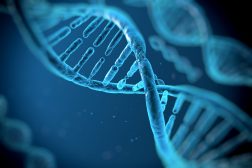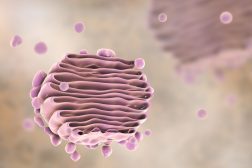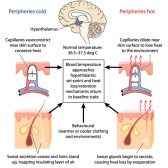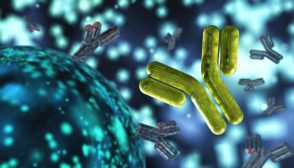Table of Contents
Definition
noun
plural: deoxycytidine monophosphates
(biochemistry) A nucleotide composed of cytosine, deoxyribose and a phosphate group, with a chemical formula: C9H14N3O7P
Details
Overview
A nucleotide is an organic compound made up of three subunits: a nucleobase, a five-carbon sugar, and a phosphate group. The sugar component may either be ribose or deoxyribose. The ribose is the sugar component of the nucleotides that make up RNA. The deoxyribose is the sugar component of DNA. Nucleotides are the monomeric units of nucleic acids. Each phosphate group connects the sugar rings of two adjacent nucleotide monomers. The phosphate groups and the sugar moieties form the backbone of a nucleic acid. The directionality of the chain runs from 5′-end to 3′-end. In DNA, the orientation of the two strands is in opposite directions. This is to allow complementary base pairing between nucleobase constituents. A nucleotide is, thus, a nucleoside with a phosphate group. Depending on the number of phosphate groups attached to the sugar moiety, it may be called nucleoside monophosphate (if with only one phosphate group), nucleoside diphosphate (with two phosphate groups), or nucleoside triphosphate (when with three phosphate groups). Depending on the pentose sugar component, a nucleoside may be a ribonucleoside or a deoxyribonucleoside. A ribonucleoside is a nucleoside with a ribose sugar component. (Depending on the nucleobase component, the ribonucleoside may be adenosine, guanosine, cytidine, uridine, or 5-methyluridine). A deoxyribonucleoside is a nucleoside with a deoxyribose sugar. Depending on the nucleobase component, a deoxyribonucleoside may be deoxyadenosine, deoxyguanosine, deoxycytidine, thymidine, or deoxyuridine. Also, depending on the nucleobase component, the nucleosides may be grouped into either the “double-ringed” purine or the “single-ringed” pyrimidine.
Deoxycytidine monophosphate is a pyrimidine nucleotide composed of cytosine, deoxyribose and a phosphate group, with a chemical formula: C9H14N3O7P
Characteristics
Deoxycytidine monophosphate (dCMP) is a nucleoside phosphate in being comprised of a deoxyribonucleoside and one phosphate group. This means that it has a deoxyribose as its sugar constituent with one phosphate group attached. Its nucleoside contains a pyrimidine base, i.e. a cytosine attached to the deoxyribose sugar. It has only one phosphate group attached to the nucleoside. Its conjugate acid form is deoxycytidylic acid whereas its conjugate base form is deoxycytidylate.
dCMP vs CMP
Cytidine monophosphate (CMP) is a nucleotide composed of cytosine, ribose and a phosphate group. It has a chemical formula of C9H14N3O8P. It differs from dCMP (chemical formula: C9H14N3O7P) in terms of the sugar component. dCMP, instead of having a hydroxyl group on the 2′ carbon of the sugar component as it is in CMP, has it reduced to a hydrogen atom (thus, deoxy- in its name). dCMP is one of the monomeric units that constitute DNA whereas CMP is one of the monomeric units that make up RNA.
Common biological reactions
Common biological reactions
dCMP forms when CMP is reduced. CMP can come from the degradation of CTP (cytidine triphosphate) and CDP (cytidine diphosphate) via hydrolysis, and then reducing the hydroxyl group of the ribose to hydrogen ion. CMP may also be derived from dietary sources (particularly, RNA-rich food). Or, it may be synthesized de novo. By the de novo synthesis pathways, cytosine, similar to other pyrimidines, is formed from a series of steps, i.e. the formation of carbamoyl phosphate → conversion into carbamoyl aspartate (via aspartate transcarbamylase) → converted into dihydroorotate → oxidized to produce orotate. 5-phospho-α-D-ribosyl 1-pyrophosphate (PRPP), a ribose phosphate, reacts to orotate to form orotidine-5-monophosphate (OMP). OMP is then converted into other pyrimidines. The enzyme OMP decarboxylase facilitates the decarboxylation of OMP to yield uridine monophosphate (UMP). Phosphorylation of UMP leads to the formation of uridine diphosphate (UDP) and uridine triphosphate (UTP). Amination of UTP leads to the formation of cytidine triphosphate (CTP) by the action of the enzyme CTP synthetase.1 Breaking down of CTP (by losing two phosphates through the action of RNAse) leads to the formation of CMP.
Biological functions
dCMP may serve as one of the monomer nucleotides in DNA when it is phosphorylated with two more phosphate groups, thus becoming dCTP (deoxycytidine triphosphate). In DNA, dCTP complementary base pairs with deoxyguanosine triphosphate (dGTP).
Supplementary
Abbreviation(s)
- dCMP
- deoxy-CMP
IUPAC
Chemical formula
- C9H14N3O6P
Synonyms
Further reading
See also
- nucleotide
- DNA
- deoxycytidine
- guanosine monophosphate (GMP)
- deoxycytidine diphosphate (dCTD)
- deoxycytidine triphosphate (dCTP)
Reference
- Charma, K. & Somani, D. (2015). Pyrimidine Biosynthesis. Retrieved from Slideshare.net website: ://www.slideshare.net/kskuldeep1995/pyrimidine-biosynthesis-46874172 Link
© Biology Online. Content provided and moderated by Biology Online Editors






